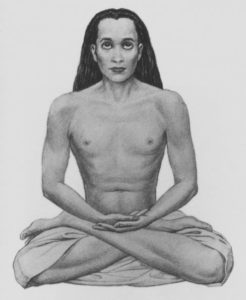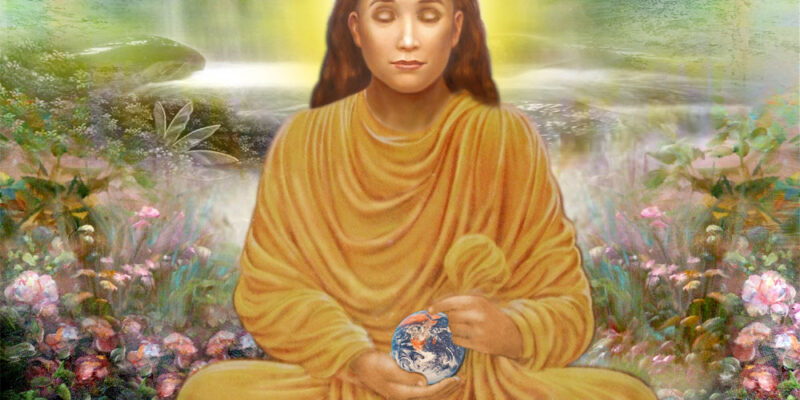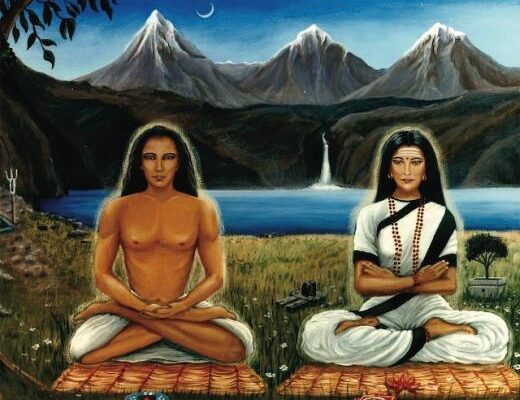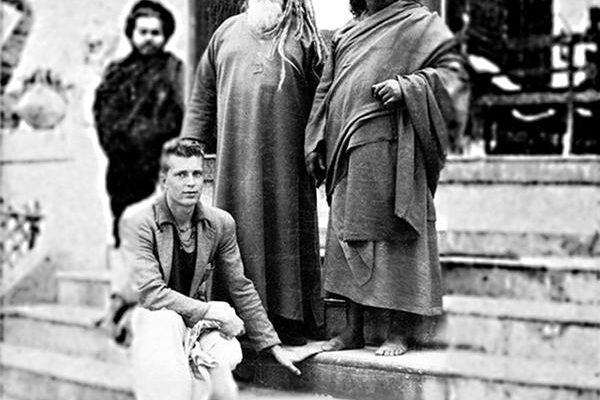Mahavatar Babaji - Founder of Kriya Yoga Sadhguru in his book "Death - An inside story" explains how Mahavatar Babaji…
Who is Mahavatar Babaji
Who is Mahavatar Babaji?

Source – babajiskriyayoga.net
In 1946, Paramahansa Yogananda, one of modern India’s greatest yogis, revealed in his classic “Autobiography of a Yogi,” the existence of a Christ-like saint, an immortal yogi, Mahavatar Babaji. Yogananda related how Babaji had for centuries lived in the Himalayas guiding many spiritual teachers at a distance, usually without their even knowing it. Babaji was a great siddha, one who had overcome ordinary human limitations, and who worked silently, behind the scenes for the spiritual evolution of all humanity. Paramahansa Yogananda also revealed that it was Babaji who taught a powerful series of yogic techniques, know as “Kriya Yoga,” to Lahiri Mahasaya, around 1861, and who subsequently initiated many others, including Yogananda`s own Christ-like guru, Sri Yukteswar, some thirty years later. Yogananda spent 10 years with his guru before Babaji himself appeared to him, and directed him to bring the sacred science of Kriya to the West. Yogananda fulfilled this sacred mission from 1920 to 1952, when he left his body and attained the yogic state of mahasamadhi.As a final tribute to the efficacy of Kriya Yoga and the blessings of his lineage, the body of Yogananda did not deteriorate during the 21 days it lay exposed, before being interred in a crypt in Los Angeles. March 7, 2002 marked the 50th anniversary of Yogananda’s remarkable passing. When his remains were transferred to a permanent “samadhi” shrine in March 2002, millions around the world remembered with gratitude what Yogananda’s legacy has given to them.
KRIYA BABAJI REVEALS HIMSELF
In South India, Babaji had been preparing, since 1942, two other souls for the task of disseminating his Kriya Yoga: S.A.A. Ramaiah, a young graduate student in geology at the University of Madras and V.T. Neelakantan, a famous journalist, and close student of Annie Besant, President of the Theosophical Society and mentor of Krishnamurti. Babaji appeared to each of them independently and then brought them together in order to work for his Mission. In 1952 and 1953 Babaji dictated three books to V.T.Neelakantan: “The Voice of Babaji and Mysticism Unlocked,” “Babaji’s Masterkey to All Ills,” and “Babaji’s Death of Death.” Babaji revealed to them his origins, his tradition, and his Kriya Yoga. They founded on October 17, 1952, at the request of Babaji, a new organization, “Kriya Babaji Sangah,” dedicated to the teaching of Babaji’s Kriya Yoga. The books created a sensation at the time of their publication and distribution throughout India. The SRF (Self Realization Fellowship) attempted to have them and the Kriya Babaji Sangah suppressed, and it took the intervention of the then Prime Minister of India, Pandit Nehru, who was a friend of V.T. Neelakantan, to end their efforts. In 2003, Babaji’s Kriya Yoga Order of Acharyas reprinted these three books in one volume called “The Voice of Babaji.”
It is in the “Masterkey of All Ills,” that Babaji reveals his answer to the question “Who Am I”. In essence, this reveals, that when we know ultimately who we are, we will know who Babaji is. That is, Babaji does not identify with a limited human personality, or series of life events, or even his divinely transformed body. However, in writings he also revealed for the first time a number of precious details about his life story, in order to outline for us a path to Self-realization, which anyone may aspire to. These details have been subsequently documented in the book “Babaji and the 18 Siddha Kriya Yoga Tradition.”
Babaji was given the name “Nagaraj,” which means “serpent king,” referring to “kundalini,” our great divine potential power and consciousness. He was born on the 30th day of November 203 A.D., in a small coastal village now known as Parangipettai, in Tamil Nadu, India, near where the Cauvery River flows into the Indian Ocean. His birth coincided with the ascendancy (Nakshatra) of the star of Rohini, under which Krishna was also born. The birth took place during the celebration of Kartikai Deepam, the Festival of Lights, the night before the new moon during the Tamil month of Kartikai. His parents were Nambudri Brahmins who had immigrated there from the Malabar coast on the western side of south India. His father was the priest in the Shiva temple of this village, which is today a temple dedicated to Muruga, Shiva’s son.
At the age of 5, Nagaraj was kidnapped by a trader and taken as a slave to what is today Calcutta. A rich merchant purchased him, only to give him his freedom. He joined a small band of wandering monks, and with them became learned in the sacred religious and philosophical literature of India. However, he was not satisfied. Hearing of the existence of a great siddha, or perfected master, named Agastyar, in the south, he made a pilgrimage to the sacred temple of Katirgama, near the southern most tip of Ceylon, the large island just south of peninsular India. There he met a disciple of Agastyar, whose name was Boganathar. He studied “dhyana,” or meditation, intensively and “Siddhantham,” the philosophy of the Siddhas, with Boganathar for four years. He experienced “savikalpa samadhi,” or cognitive absorption, and had the vision of Lord Muruga, the deity of the Katirgama temple.
At the age of 15, Boganathar sent him to his own guru, the legendary Agastyar, who was know to be living near to Courtrallam, in Tamil Nadu. After performing intensive yogic practices at Courtrallam for 48 days, Agastyar revealed himself, and initiated him into Kriya Kundalini Pranayama, a powerful breathing technique. He directed the boy Nagaraj to go to Badrinath, high in the Himalayas, and to practice all that he had learned, intensively, to become a “siddha.” Over the next 18 months, Nagaraj lived alone in a cave practicing the yogic techniques which Boganathar and Agastyar has taught him. In so doing, he surrendered his ego, all the way down to the level of the cells in his body, to the Divine, which descended into him. He became a siddha, one who has surrendered to the power and consciousness of the Divine! His body was no longer subject to the ravages of disease and death. Transformed, as a Mah or great siddha, he dedicated himself to the upliftment of suffering humanity.
BABAJI’S LONGEVITY
Since that time, over the centuries, Babaji has continued to guide and inspire some of history`s greatest saints and many spiritual teachers, in the fulfillment of their mission. These include Adi Shankaracharya, the great 9th century A.D. reformer of Hinduism, and Kabir, the 15th century saint beloved by both the Hindus and Muslims. Both are said to have been personally initiated by Babaji, and refer to him in their writings. He has maintained the remarkable appearance of a youth of about 16 years of age. During the 19th century Madame Blavatsky, the founder of the Theosophical Society, identified him as the Maitreya, the living Buddha, or World Teacher for the coming era, described in C.W. Leadbetter’s “Masters and the Path.”
Although Babaji prefers to remain obscure and invisible to others, he does on occasion gradually reveals himself to his devotees and disciples, capturing their hearts in various types of personal devotional relationships in which he guides them in their development. His relationship with each of us is unique and according to our individual needs and nature. He is our personal Guru. As our hearts expand our communion with Him culminates with the “universal vision of love,” wherein one witnesses Babaji in everything.
BABAJI’S REVIVAL OF KRIYA YOGA
Babaji revives Kriya Yoga, which Siddha Patanjali refers to in his famous “Yoga-Sutras.” Patanjali wrote his classic text of yoga about the 3rd century A.D. In it he defines Kriya Yoga in II.1 as “constant practice (particularly by the cultivation of detachment), self-study and devotion to the Lord.” However, along with what Patanjali described as Kriya Yoga, Babaji added the teachings of the tantra, which includes the cultivation of “kundalini,” the great potential power and consciousness, through the use of breathing, mantras and devotional practices. His modern synthesis of “Kriya Yoga,” includes a rich variety of techniques. It was in 1861 that Babaji initiated Lahiri Mahasaya into his powerful Kriya Yoga system.
OTHER TECHNIQUES OF KRIYA YOGA ARE REVEALED BY BABAJI
During a six month period in 1954, at his ashram near Badrinath, in the Garwhal Himalayas, Babaji initiated a great devotee, S.A.A. Ramaiah into a complete system of 144 Kriyas, or practical techniques, involving postures, breathing, meditation, mantras and devotional techniques. The latter blossomed as a yogi, and began a mission to bring this system, referred to as “Babaji`s Kriya Yoga” to thousands of aspirants ALL AROUND THE WORLD.
Fortunately, Babaji comes out from behind the veils of anonymity which he finds so useful for his work. Babaji has appeared to Swami Satyeswarananda in the Kumaon Hills of the Himalayas, in the early 1970`s and given him the assignment of translating and publishing the writings of Lahiri Mahasaya. This he has done in a series, the “Sanskrit Classics,” from his home in San Diego, California. Babaji gave his “darshan” on the vital plane to the author, M. Govindan, in October 1999, on two occasions. This occurred 30 kilometers north of Badrinath, at an altitude of nearly 5,000 meters, at the source of the Alakananda River. During these visitations, Babaji appeared as a radiant youth, with copper colored hair, clad in a simple white “dhoti” or waist cloth, and allowed Govindan to touch his feet.
BABAJI’S ATTAINMENT
One cannot really know who Babaji is, or even begin to conceive of his grandeur, without appreciating the culture of the Siddhas from which he has emerged. Rather than seeking an other worldly escape in some heaven, after realising the presence of the Divine within, the Siddhas sought to surrender their entire being to It, and to allow It to manifest at all levels. They sought a complete transformation of our human nature.
“Thirumandiram,” by the Siddha Thirumoolar, written in the 2nd to 4th century A.D. in 3,000 gem like verses, reveals the breath and depth of the Siddhas attainments. Our research has revealed that Thirumoolar was a brother disciple of Boganathar, Babaji’s guru, and of Patanjali, one of the most well known sources of Yoga. While most of the Siddha’s literature has not been translated outside of their native language of Tamil and Sanskrit, there exist a few good studies, most notably Dr. Kamil Zvelibil’s “Poets of the Powers,” and Professor David Gordon White’s “The Alchemical Body.” Both of these academic works demonstrate at length the remarkable attainments of the Siddhas, and reveal that Babaji was not some unique extraterrestrial. He manifests what Sri Aurobindo referred to and aspired to for all humanity: “the supramental transformation” of our human nature, perhaps the next step in our evolutionary process. As such, he is not our savior. Nor is he the founder of some religion. He does not seek our adulation or even our recognition. Like all of the Siddhas, he has surrendered completely to the Supreme Being, the Supreme Abstraction, and as a divine instrument, brings down into this murky world the clear light of consciousness, unconditional joy and supreme peace. May everyone achieve this greatest human potential.
Ayyappa Giri, another disciple of Yogi Ramaiah writes about Babaji
The Emergence of an Avatar
Though known secretly by Kriya Yogis for centuries, details of the life and birth of the deathless Mahasiddha Babaji were not made public until the late 1940’s, when the saintly Swami Yogananda Paramahamsa was permitted to release a few details of Babaji’s incredible incarnation. Later, the great saint included a chapter about Babaji in his magnus opus, “Autobiography of a Yogi”.
In 1952, the celebrated and eternally youthful avatar revealed his birth details to two of his very close disciples. One had authored several books on Kriya Yoga, V.T. Neelakantan. The other was my own Gurudev, the Tamil Pranayam Siddha, Yogiar S.A.A. Ramaiah.
Babaji’s Birthplace and the Temple Upon Which it Sits
The great master had not revealed any details of his birth prior to the 1950’s. In the last few decades, Babaji has become a worldwide phenomena, particularly among mystics, yogis and tantrics. He works in all levels and has integrated into the consciousness of awakened souls everywhere. He was born in Swethanathapuram, an ancient seaport near Chidambaram, India on 30 November, 203 A.D. The town is now known as Parangipettai. In the early 1950’s, Babaji led Neelakantan and Yogiar to the sacred site at the very beginning of Yogiar’s decades long spiritual mission.
During 1971, I did intensive sadhana at Babaji’s Birthplace on many occasions. The plot of land was filled with thorns and rocks, but to me, it was a place of great peace, power and bliss. There were no shade trees and the summer sun of south India was scorching hot. Nevertheless, I was determined that the mind not be influenced by the physical discomfort. With the help of the vibrations present and a strong effort to go deep within, I was floating in and out of a timelessness; a place of no thought, One hour, then two hours passed. After some time a wetness, movement, and distinct pressure was felt on the face and body, as I was not wearing a shirt. The sensations gradually pulled me out of that deep state. As I opened my eyes, I was delighted to see that a lovely cow was licking my face and chest. I am sure that he was enjoying the salt from my perspiration but at the time, I could only think of Lord Krishna!
Soon after that, Yogiar asked Kriya Yoga Sadhaks Marshall Govindan and myself to fly to Delhi to meet with the Minister of Aviation and Tourism, Dr. Karan Singh. The purpose was to purchase from the Indian government the small plot of land on which Babaji was born, in order to build a temple open to all. With the full authority of Babaji, Yogiar made that request of us, and it never even occurred to me for a moment that it would not be achieved. I remained in India working on the project and after more than a year of effort and massive grace from Babaji who was pulling strings behind the scenes, the dream was realized.
Yogiar then asked me to supervise the construction of a granite temple dedicated to Babaji on the holy site. The rough granite slabs were quarried near Kanadukathan and moved by bullock cart to the carving location. The carvings and reliefs were performed in the town of Karakudi in the ancient tradition. I remember doing mantras for many hours while the tic, tic, tic of the stapadi carvers worked in the background. When the carved blocks and images were complete, and the temple was ready to assemble, all were transported by trucks to Babaji’s birthplace. For the next two months of construction, monsoon season peaked and it rained constantly as we approached the deadline for dedicating the temple, which had been determined astrologically far in advance. The workers were corragously moving the massive stone blocks with levers as they sloshed through mud and rain chanting the names of God to maintain the rhythm of the work and keep their energy high.
When the construction was complete, even as the rain continued, I was given the massive honor of working with the Brahmin priests as we prepared the astabandha (a special kind of cement) to secure Babaji’s moorthi to his pedestal.
A Blessing from Babaji at the Dedication Ceremony
Miraculously, as we began the Mahakumbh Abeshak (the first ceremonial bath) at the sacred hour, the rains stopped for the very first time in many weeks. The clouds parted and a beam of light descended directly on the temple itself. The light beam remained on the temple until the puja was complete. Dear friends, I am not exaggerating one iota. One single beam of light maintained its position on the temple throughout the puja, while no other light in any direction could be seen.
Yantras and other secret things of which I cannot speak were placed strategically and in a safe hidden place within the granite itself. Then, just at the conclusion of the puja, the rains began again and showered the region for yet another two weeks. It was more rain than the region had received in many years. In yoga, rain is considered a great blessing from the divine, for with it, crops flourish and people are nourished.
The temple is built to last for thousands of years. The quality of granite holds up extremely well over the centuries. Although small, it is very artful and energetically magnificent. The tranquility of the grounds is amazing. Scenes from Babaji’s life are depicted in granite reliefs around the top of the temple. All Kriya Yoga Sadhaks and devotees of Babaji should should go to this power spot at least once in their lifetime.
Babaji in our Current Era
“The breath that arose 12 matras long; if you can control and absorb within, well may you live a thousand years on land and sea; for the body, perishes not.”
Thirumandiram V722
High in the remote rocky mountains of the Kumoan Himalayas, the eternal Babaji lives today, as he has for millennia, retaining his physical form only for the benefit of humanity. It has long been understood that those who descend from the celestial realm (avatars) often bring with them outward signs of their inward freedom. Thus, there have been other Avatars that cast no shadow or footprint. There are others as well who have breathed life into a corpse or instantly moved through time and space with impunity. There have been others too, who lived without food or drink, who walked upon water, or moved upon air. But few are they whose physical form, manifesting the golden light of immortality, does not decay or age. And few indeed are they who can move through the physical world with mastery of every plane of existence, fully active and yet with breathing and mind perfectly stilled. Babaji reigns supreme as the great avatar of Vedanta, Siddhantha, and Kaula Marg Tantra. He is at the headwaters of all the sacred tributaries of Yoga and Tantra. From him has emerged every stream of Kriya itself and his guiding hand is ever present.
He is seen and recognized only by those whom he chooses. Although he has appeared in many forms over the centuries, he frequently manifests as a timeless youth. His black hair is aflame with copper-golden rays of light-energy and his well toned body reflects that of an athletic youth. His dark eyes, awash with light and love, penetrate the soul. His countenance is surrounded with authority and mystery. He is approachable and seen only by those of purified consciousness. He is known as the great yogi, the ancient youth of sixteen summers, as he attained immortality at a young age. His presence is not frightening at all, as some have thought. His presence is massively calming. In his presence one can think only what he allows. It is impossible to approach him without his inward permission. He is the great guiding father who was the loving guide behind all ones earthly fathers in every lifetime.
Who is this great mysterious yogi who cannot be reduced to a rule? Lahiri saw him as an incarnation of Krishna. Yogi Ramaiah maintained that he and Muruga, the Dravidian Lord of beauty, were one and the same. He has been revealed to us as an avatar of Maha Shiva. Still other Kriya yogis have identified him with Kali or Christ. Like the cosmic Lord, he manifests the form and energy held dear by the devotee, nor can any mortal reduce him to a rule. The stellar star of his attainment is impossible for the mortal mind to comprehend. He is both multicultural and multi-linguistic and demonstrates a freedom from any limit. Every aspect of his remarkable life reflects this freedom. Miraculous stories of his life, including bringing the dead to life, manifest multiple bodies at the same time, and the ability to appear and disappear at will abound. He is so much more than an astral being, limited to a ghost body. He manifests a physical body with toes that have form and substance like an human being, except that they project light, fragrance and bliss when touched.
In 1888 Madam Blavatsky, founder of the Theosophical Society described Babaji in her great treatise, the Secret Doctrine, as follows, “It is He who changes form, yet remains ever the same, and it is He, again, who holds spiritual sway over the initiated adepts throughout the world. He is, as said, the nameless one who has so many names and yet, whose names and very nature are unknown. He is THE INITIATOR, called the GREAT SACRIFICE for sitting at the threshold of Light, He looks into it from within the circle of darkness which He will not cross, nor will He quit His post until the last day of this life-cycle. Why does the solitary watcher remain at His self chosen post? Why does He sit by the fountain of primeval wisdom, of which He drinks no longer, for He has naught to learn which He does not know – aye, neither on this earth nor in its heaven? Because the lonely sore-footed pilgrims, on their journey back to their home, are never sure to the last moment of not losing their way, in this limitless desert of illusion and matter called earth-life. Because He would show the way to that region of freedom and light from which He is a voluntary exile himself, to every prisoner who has succeeded in liberating himself from the bonds of flesh and illusion. Because, in short, He has sacrificed Himself for the sake of mankind, though but few elect may profit by the great sacrifice.”
Babaji as a Tantric
Many people are aware of Babaji’s contribution to Yoga and Kriya. Few, however, are aware of his achievements as a tantric master, along the lines of the Siddha Macchindranath. The Tamil Tantric, Rudranath Giri Maharaj, has revealed that Babaji is the avatar of great sacrifice for the emerging golden age of Kriya and that his glorious Shakti, taking form as Bhairavi, has regenerated the Kaula Marg tantric path as well, for the benefit and spiritual growth of all humanity. For Babaji and Mataji, a hundred years is but a day. Together they performed dynamic tantra sadhana in a small triangular cave near Gangotri. They have always worked quietly behind the scenes. Thousands of world and spiritual leaders are influenced by their “taps” at critical times, although most in an unconscious way. They seek absolutely no acknowledgment as they guide many toward spiritual awakening. They work on all planes and are literally “a bridge for those who seek the farther shore”. A siddha in the ultimate sense is one who has attained perfection in all planes, including the physical. As defined in the upanishads, a siddha is one who has progressed from the exalted state of freed while living (jivan mukta) to supremely free with full power over death (para mukta). This state is referred to in the Siddhantha tradition as soruba mukti or soruba samadhi.
Babaji Speaks
Who is Babaji? Like God himself, he morphs into the forms that the devotee holds dear. He resides in the formless forms as well, such as the great tradition of Monism expounded by Adi Shakaracharya (who he initiated). Speaking in Ecstasy, Babaji once demonstrated his mastery of the Advaita Vedanta path as he literally described his consciousness to his chosen disciples, V.T.N and Yogiar as follows.
“I am existance-knowledge-bliss absolute. I am the absolute and supreme Self, both within and without the finitude. I am truth, eternal and everlasting. I am the only one, all in myself: None exist save I, in and through all that exists. I am ever all-existence itself. I am the changeless one in the midst of all changes. I am the formless in all forms…I am the living ocean of ecstasy that rages wild and surges and storms and levels down the earth and heavens. I beat in every breast, see in every eye, throb in every pulse, smile in every flower, shine in the lightning and roar in the thunder. I flutter in the leaves, I hiss in the winds, and I roll in the surging seas. I am the wisdom of the wise, the strength of the strong, the heroism of the heroic. I am the impersonal personality of the whole universe. I am the infinite, the eternal, and the immortal Self. Truth flows from me just as light radiates from the sun and fragrance emanates from a flower am the immutable and indescribable Atman, the dynamic principle of existence and the infinite ocean of everlasting conciseness.”
Kriya Babaji
His Early Years
Babaji has revealed that he was kidnapped at an early age from his home town and taken to north India to be sold into slavery. In present day Kolkata, he was purchased and soon released where he migrated to Varanasi. In due course, he mastered the principles of both Vedanta and Siddhanta, and pierced the barriers to understanding the Siddhas. Having reached the limitations of academic knowledge, he began an extensive pilgrimage and course of sadhana. From the coast of Bengal, he undertook a pilgrimage by boat to the site of the Kali temple in Chittagong and also the powerful Chittagong Hill in Bangladesh. There, following intense sadhana, he had daily exchanges with Maa Kali and became intimate with her majesty, power and grace, mastering the path of Kaula Marg Tantra. He experienced Kali very tangibly in all her 64 emanations (64 Yoginis). Later, Babaji influenced other Siddhas like Vashistha and Macchendranath (Macchamuni) who elevated Kaula Marg Tantra to a grand tradition. This led to the construction of 64 Yogini Temples, mostly in north India. That hill, where Babaji performed tapas, later became a Bhavani Shakti temple, and in later centuries, identified as one of the celebrated 52 Shakti Peeths, or vortex shrines of Devi. It seems that he returned to that hill temple in later centuries. Imagine my surprise when, after more than 20 years of yogic practice, I received the Maha Kali Chew Mantra, the connection between Kali and Babaji was explained to me, and I observed the name of this very Shakti Peeth of Chittagong embedded within the mantra. This is the same powerful mantra that had been given by Babaji himself directly to Yogiar’s maternal grandfather, and then passed on to Yogiar’s mother (Sm. Solachi). It was then passed to Yogiar, then to Shivagami (Swami Mantradikshananda).
Returning to Kolkata, Babaji sailed to Katirgama, Sri Lanka, where he ultimately experienced Nirvakalpa Samadhi, the breathless state of God and Truth union. In doing so, he reestablished an ancient and powerful link with the 18 Siddhas, particularly the scientific Siddha, Bogar.
Babaji then journeyed to Coutrallam in Tamil Nadu, where we was initiated into Kriya by another of the 18 Siddhas, Sage Agasthiya. He then migrated to a cave in the high Himalayas and performed tapas for five years. In the process, the very atoms of his physical body were permeated with and transformed by divine light-vibration. From that point on, he had no shadow and he had no footprint.
His dynamic second cousin, Mataji, soon joined him and following his lead, attained a similar state, the golden deathless body of Soruba Samadhi. Yogananda introduced Mataji as Babaji’s sister or cousin-sister, a common term of endearment in Indian culture. Yogi Ramaiah, who also spent time with Babaji in the physical body, explained a different reality than that. Let there be no ambiguity about the relationship of Babaji and Mataji. Yogiar many times confirmed that Babaji and Mataji were in a Shiva-Shakti union. Every disciple of Yogiar would be aware of this. My Kaula Marg Tantra Guru, Swami Rudranath Giri Maharaj, has revealed that together, Babaji and Mataji worked through the 64 Tantric Kriyas without a fall. Thus, having mastered the paths of Vedanta, Siddhantha, and Kaula Marg Tantra together, Mataji ascended into her predestined avatarship.
I will continue to share what Babaji has given me, particularly Kriya Kundalini Pranayam, Bhairavi Kriya and the other advanced techniques. Advanced Yoga Teacher training is available as well as advanced classical Tantra training in the Kriya tradition. The training utilizes an ancient and powerful breathing practice revealed by Mataji as Bhairavi Kriya or Breath of Ecstasy. Additionally, a teachers training program offers incremental training in the 64 tantric kriyas of Kaula Marg, the path of energy, transmutation of sexual essence and mastery of the nadis relating to procreation and sexuality. A major key is understanding the relationship and energies between the 64 tantric kriyas and the 64 Yoginis, all forms of MahaKali.
Babaji, you are our light and guide. Awaken us from the slumber of the ages, Please guide every thought, every action, every desire toward purity and light. Humble us, that we may be receptive to your Grace. Above all, shepherd us through the transition at the end of each life with a firm but kind hand that we may reside eternally at your lotus feet and serve the light forever. May Atman alone dominate the consciousness! May the power and majesty of your light and love manifest in every plane and every cell. Let the akashic record reflect that we lived nobly in each moment.



